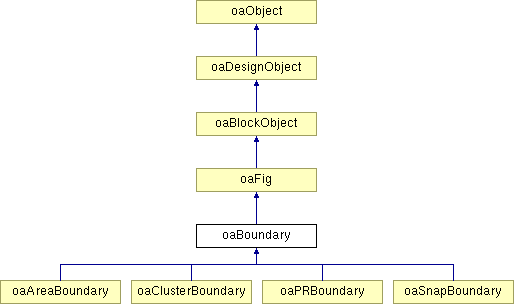 |
 |
 |
||||||
Inheritance diagram for oaBoundary:

 |
 |
Public Methods | |
| void | getPoints (oaPointArray &points) const |
| void | getEdgeNames (oaString *edgeNamesIn) const |
| oaUInt4 | getNumEdges () const |
| oaBoolean | hasDefaultConstraintGroup () const |
| oaConstraintGroup * | getDefaultConstraintGroup () const |
| void | setEdges (const oaPointArray &points, const oaString *edgeNames=NULL) |
| void | transform (oaDouble scale, oaDouble angle) |
| void | getEdgeNames (oaStringArray &edgeNamesIn) const |
| void | setEdges (const oaPointArray &points, const oaStringArray &edgeNames) |
Public Types | |
| enum | { dtIndex = oacBoundaryDataType } |
Two coincident and three collinear points are illegal, and if detected, cause an exception to be thrown. You can use oaPointArray::compress() to remove these combinations.
The oaBoundary class can be observed by deriving from oaObserver<oaBoundary>.
|
|
This function returns the default constraint group for this boundary. If no constraints have been set on the default constraint group, a new constraint group is created and returned. |
|
|
This function fills in edgeNamesIn with the names of each edge of this boundary.
|
|
|
This function is deprecated. Refer to the getEdgeNames function that takes a reference to an oaStringArray for edgeNamesIn. This function fills out the edgeNamesIn array with the names of each edge of this boundary.
|
|
|
This function returns the number of edges in this boundary. |
|
|
This function fills out the given oaPointArray with the points of this boundary.
|
|
|
This function returns a boolean indicating whether there is a default constraint group for this boundary. |
|
||||||||||||
|
This function sets the point array and edge names array of this boundary to the specified points and edgeNames, respectively. Note that the number of edge names must be equal to the number of points or an oacBoundaryInvalidEdgeNames exception is thrown.
|
|
||||||||||||
|
This function is deprecated. Refer to the setEdges function that takes a reference to an oaStringArray for the edgeNames. This function sets the point array and edge names of this boundary to the specified points and edgeNames respectively. If boundary edgeNames are not supplied, the edges are automatically named using the form EDGE_n, where n starts at zero and increments by one. Note that the number of edge names is assumed to be equal to the number of points. Note: The order of the points actually set on the oaBoundary is not guaranteed to be the same as the order of points passed to the setEdges() function. Consequently, the order of points returned by a subsequent oaBoundary::getPoints() may be different from the order of points specified in points.
|
|
||||||||||||
|
This function transforms this boundary by the specified scale factor and rotation angle.
|
|
|
|

Copyright © 2002 - 2010 Cadence Design Systems, Inc.
All Rights Reserved.